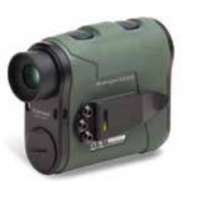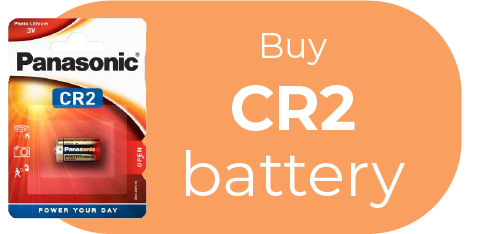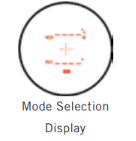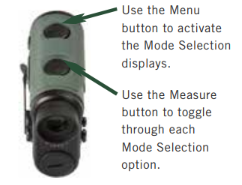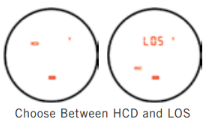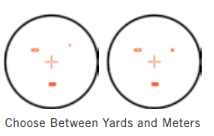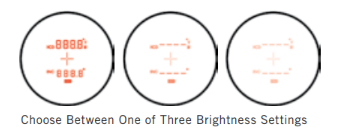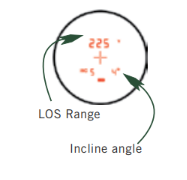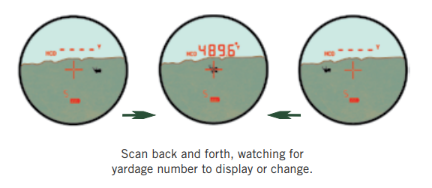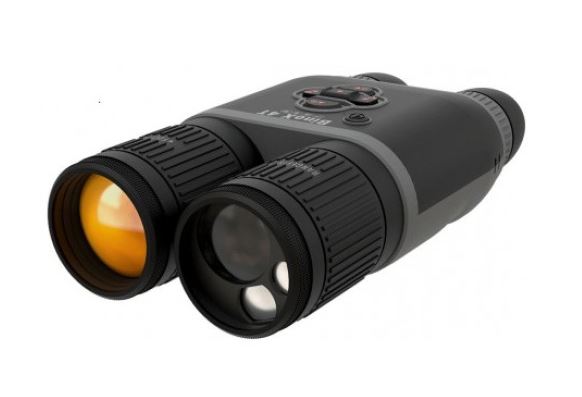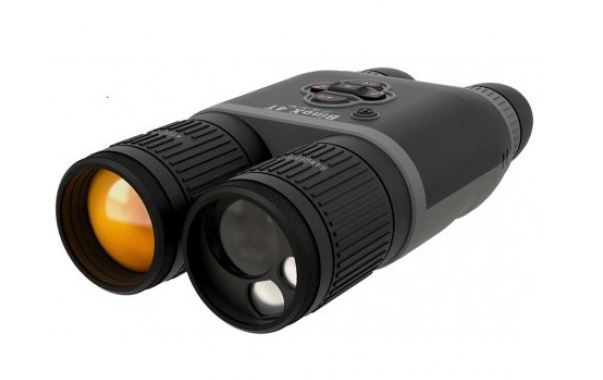Ranger 1800 Specifications
Range Reflective: 9–1800 yards (9–1646 meters)
Range Deer: 9–900 yards (9–822 meters)
Accuracy: + /- 3 yards @ 1000 yards
Maximum Angle Reading: +/- 60 degrees (INC 50)
Measuring Time: < 1 second
Battery Life: 2000 single range minimum
Operating Temperature: 14° to 131°F (–10°to 55°C)
Magnification: 6x
Objective Lens: 22 mm
Eye Relief: 17 mm
Diopter: +/- 3 diopters
The Ranger 1800 Rangefinder
The Ranger is an extremely effective angle compensated laser rangefinder intended for both archer and rifle shooter. Using the primary HCD (Horizontal Component Distance) mode, the Ranger provides the key angle compensated range information required by the vast majority of rifle and bow shooters in a simple, quick to read display.
The Ranger also provides LOS (Line of Sight) mode and Scan feature along with adjustments for reading in yards or meters and setting the brightness of the display.
-

Vortex Ranger 1800
Please be sure to read entire manual prior to using the Ranger.
-

Vortex Ranger 1800
Basic Operation
-

Vortex Ranger 1800
Install Battery
Open the battery compartment and install the CR2 battery included with the Ranger.
Need an additional battery?
Power Up
-

Vortex Ranger 1800
Once you install the battery, the Ranger is in Ready Condition—the normal power-off condition when not ranging. To power up the Ranger from Ready Condition and prepare for ranging, press and release the Measure button. The HCD or LOS ranging screen will display. The Ranger will power down automatically after ten seconds of non-use.
Focus
Turn the eyecup in or out until image is sharp.
Mode Selection
-

Vortex Ranger 1800
Your Ranger is factory set to the angle compensating HCD mode, yards, and medium brightness. For most users, these are the preferred settings.
To change modes, after the Ranger is powered up activate the Mode Selection by pressing and holding the Menu button for at least four seconds. Once the Mode Selection screen displays, release the button.
As you progress through Mode Selection, you may exit at any time and save your settings by pressing and holding the Menu button for at least four seconds—the Ranger will then return to power-up condition.
-

Vortex Ranger 1800
Set and Save Mode Selections in 3 Steps
1. Choose between the HCD and LOS Modes.
-

Vortex Ranger 1800
After activating the Mode Selection, press the Measure button to toggle between the HCD and LOS displays. Press the Menu button to save your desired choice and move to the Yards/Meters selection screen.
2. Choose between Yards and Meters Display.
-

Vortex Ranger 1800
Press the Measure button to toggle between the Yards and Meters display. Press the Menu button to save your desired choice and move to the Brightness selection screen.
3. Choose the Brightness Setting.
The Ranger provides three illumination settings. Press the Measure button to toggle through the three Brightness settings. Press the Menu button to save your desired setting and move back to HCD/LOS selection screen.
-

Vortex Ranger 1800
To exit Mode Selection and save settings, press and hold the Menu button for four seconds. Settings will also save when Ranger powers down automatically.
Ranging
With the Ranger powered up, position the crosshair on the target object and press and release the Measure button to get the distance measurement. If the laser is not able to range due to the reflectivity of the target, you will see a display similar to that shown here. To range a new target, simply reaim and press the Measure button again.
Scan Ranging
With the Ranger powered up, activate Scan Ranging by pressing and holding the Measure button down. A blinking “S” will appear in the lower left corner.
Keeping the button depressed will continuously measure distance as you pan the crosshair back and forth across target objects. Releasing the Measure button will return laser to the Power Up Condition.

Ranging Mode Explanations
The Ranger provides two range modes: HCD (Horizontal Component Distance) and LOS (Line of Sight). Both modes offer a Scan feature.
HCD Mode
The Ranger HCD range display is intended to be the primary mode—used for most all rifle and archery shooting conditions. The yardage number displayed is the critical horizontal component distance.
-

Vortex Ranger 1800
Using the HCD Mode
Use the HCD range mode in the following situations:
- Rifle shooting on level ground at any range.
- Rifle shooting out to ranges of 800 yards with mild slopes (less than 15 degrees).
- Rifle shooting out to ranges of 400 yards with moderate slopes (15 to 30 degrees).
- For all archery shooting.
Note: See page 13 for method of reading slope degree in LOS mode.
The displayed HCD yardage number is corrected for shot angle and needs no extra user input; shooters simply use the appropriate level ground bullet drop and wind adjustment for the range displayed and shoot. Archers use the appropriate level ground sight pin for the range displayed and shoot.
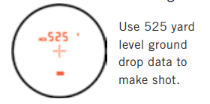 Vortex Ranger 1800
Vortex Ranger 1800
LOS Mode
The Ranger LOS (Line of Sight) mode is intended for rifle shooters who are using slope correcting ballistic drop data cards, ballistic cell phone applications, or PDAs with ballistic programs and who are shooting at distances beyond 500 yards and with slopes greater than 15 degrees. Most shooters and archers will not need the LOS mode.
The range number displayed in LOS mode is the actual line of sight range with no ballistic correction for slope. Most of the commonly used ballistic devices can provide independent slope correction for bullet drop data and require actual line of sight range input. Using the LOS range when calculating bullet wind drifts under these steep slope/long range conditions will provide a higher degree of accuracy than using the HCD range.
To use, simply input the LOS range number into the electronic device or use the LOS range when referencing ballistic drop cards with slope correction.
LOS Mode – Using the INC Number
When in LOS mode, an additional number is displayed below the yardage number. This number is slope shown in degrees.
-

Vortex Ranger 1800
The slope incline number can be used with drop charts or field cards to calculate precise bullet drops in mountainous terrain.
Scan Feature
The Scan feature can be used to range moving targets or help range smaller targets on uniform backgrounds in either HCD or LOS modes. Once powered up, press and hold the Measure button and scan laser back and forth, watching for changes in the yardage number as crosshairs move across the target object. A blinking “S” display indicates Scan Ranging is activated.
-

Vortex Ranger 1800
Want to know more about scan mode? Watch the video below.
Tripod Use for Ranging
Using a tripod to steady the rangefinder will increase your ability to range small targets at longer distances. If the Ranger is used on a tripod, the reticle may appear tilted depending on tripod level.
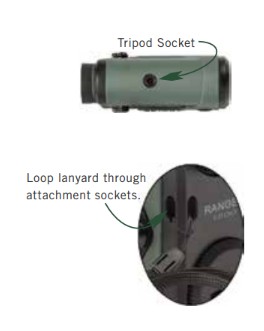
Need a tripod to secure your rangefinder?
Lanyard
When not using a tripod, the lanyard provides a secure way to carry your rangefinder.
Maintenance
- Use lens brush to remove dust or grit from lenses.
- Use a clean lens cloth or tissue to remove smudges or smears from lenses.
- Store rangefinder in a dry location away from direct sunlight.
Rangefinding Tips
Laser rangefinders work by emitting a brief pulse of light aimed at a target object. Distance is determined by the amount of time taken for the light to emit and return to the laser’s internal receiver. A laser’s ability to read range can be affected by many things—mostly relating to the target objects. Under ideal conditions, the Ranger can be expected to range a large reflective object out to 1300 yards and deer-sized game out to 650 yards.
- Light colors will usually reflect the laser pulse better than dark ones. An exception would be snow, which can be difficult to range.
- Shiny, reflective surfaces will usually reflect the laser pulse better than dull, textured surfaces. Animal hair will not reflect as well as a hard surface.
- Ranging while under cloud cover can improve laser performance compared to ranging while under bright sunny conditions.
- Solid objects, such as rock piles, will reflect the laser pulse better than less dense items such as bushes.
- Flat surfaces perpendicular to the laser pulse will reflect better than curved surfaces or surfaces angled in relation to laser pulse.
- Ranging over water can sometimes cause false reflections and readings.
- At longer distances, larger objects will be easier to range than small objects.
- If you are having difficulty ranging an animal or object, try ranging a different nearby object or use the Scan feature to pan back and forth while watching for changes in range number.
FCC Requirements
The user’s manual or instruction manual for an intentional or unintentional radiator shall caution the user that changes or modifications not expressly approved by the party responsible for compliance could void the user’s authority to operate the equipment.
Note: This equipment has been tested and found to comply with the limits for a Class B digital device, pursuant to part 15 of the FCC
Rules. These limits are designed to provide reasonable protection against harmful interference in a residential installation. This equipment generates, uses and can radiate radio frequency energy and, if not installed and used in accordance with the instructions, may cause harmful interference to radio communications. However, there is no guarantee that interference will not occur in a particular installation. If this equipment does cause harmful interference to radio or television reception, which can be determined by turning the equipment off and on, the user is encouraged to try to correct the interference by one or more of the following measures:
- Reorient or relocate the receiving antenna.
- Increase the separation between the equipment and receiver.
- Connect the equipment into an outlet on a circuit different from that to which the receiver is connected.
- Consult the dealer or an experienced radio/TV technician for help.
Laser Safety and Precautions
Do not stare into beam or view directly without laser eye protection. Staring continuously into beam for prolonged periods of time could cause harm to your eyes. If used properly, this device is safe for your eyes and laser eye protection is not needed.
- Use the correct battery (CR2) and proper battery orientation.
- Do not look at sun.
- Do not activate Menu or Measure buttons while aiming at eye or looking into objective lens.
- Do not disassemble.
- Do not allow children to play with unit.

VIP Warranty
We build optics based on our commitment to your absolute satisfaction. That’s why our products are unconditionally guaranteed and we make this Very Important Promise to you—a Very Important Person.
Rest assured that in the event your optic becomes damaged or defective, we will repair or replace it at no charge to you. If we cannot repair your optic, we will replace it with an optic in perfect working order and in equal or better physical condition. Call us at 800-426 0048 for prompt, professional, and friendly service.

2120 West Greenview Drive
Middleton, WI 53562
[email protected]
Visit www.vortexoptics.com for more information.
The VIP Warranty does not cover loss, theft, deliberate damage or cosmetic damage that does not hinder the performance of the product.
Product: https://www.optics-trade.eu/en/vortex-ranger-1800.html
This text is a transcription of the file in PDF format.
